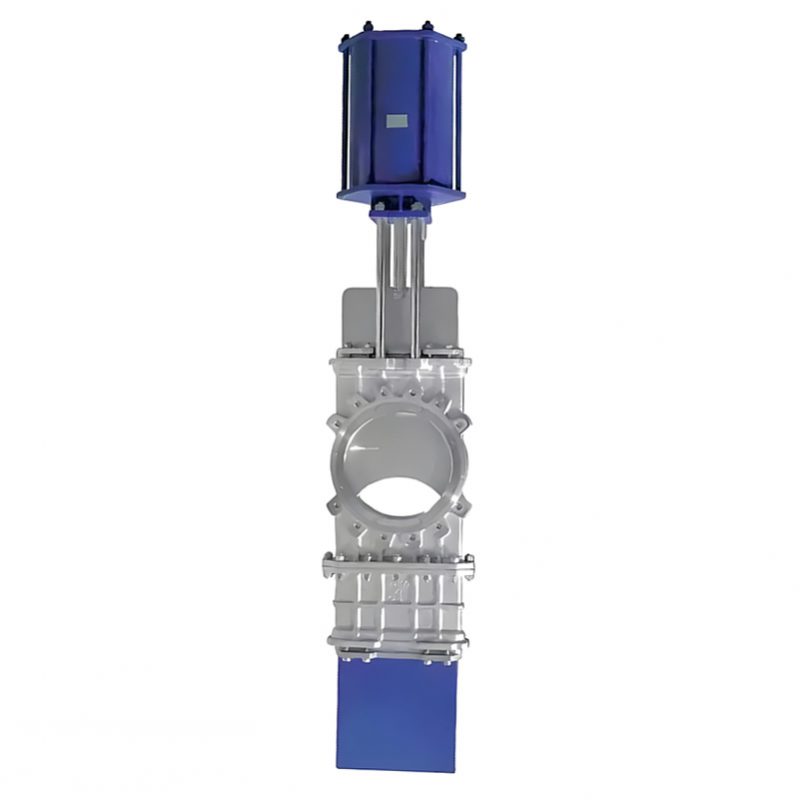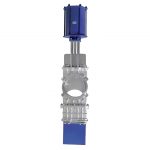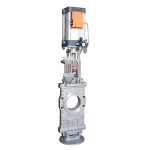TIANYU DN50-DN400 PN10/PN16 Pneumatic Through Conduit Knife Gate Valve: Abrasive-Resistant Ductile Iron/Stainless Steel Flow Control Solution for Metallurgical Slurry & Industrial Media
I. Product Overview
II. Key Attribute Specifications
A. Dimensional & Pressure-Temperature Parameters
- Nominal Diameter (Port Size): DN50 to DN400 (2 inches to 16 inches), covering the core range of medium-to-large industrial pipelines handling slurry and bulk media. The through conduit (full-port) design ensures an unobstructed flow path with a diameter matching the pipeline inner diameter, minimizing pressure drop and preventing media buildup. The flow coefficient (Cv) ranges from 70 (DN50) to 1800 (DN400), enabling efficient transfer of high-density slurries—for example, a DN400 valve can handle up to 2500 m³/h of metallurgical slurry with solid content up to 35%, meeting the flow demands of blast furnace slag transport or ore processing lines.
- Pressure Rating: PN10 (1.0MPa) and PN16 (1.6MPa), aligning with industrial low-to-medium pressure standards for slurry and general media applications. Hydrostatic testing adheres to API 598: 1.5×rated pressure for the valve shell (e.g., 2.4MPa for PN16) and 1.1×rated pressure for the seat (e.g., 1.76MPa for PN16), ensuring structural integrity and leak-tight performance under operating loads.
- Temperature Range: Ambient to high-temperature (up to 300℃), enabled by ductile iron’s thermal stability, stainless steel’s heat resistance, and compatible sealing materials. This range covers medium-temperature industrial fluids (e.g., mineral oil, process water) and high-temperature applications (e.g., metallurgical slag slurry, hot chemical streams), adapting to the diverse needs of the metallurgical and industrial sectors.
B. Material Composition
- Valve Body & Bonnet:
- Ductile Iron (QT450-10): Standard material for general industrial use, featuring tensile strength of 450MPa, yield strength ≥310MPa, and excellent impact resistance. Ductile iron’s ductility prevents brittle fracture under pressure fluctuations and vibration—common in metallurgical plants—while its cost-effectiveness makes it ideal for non-corrosive media applications. The surface is coated with anti-corrosive epoxy paint (ISO 12944) to resist rust in outdoor or humid environments.
- Stainless Steel (304/316, ASTM A182): Recommended for corrosive media (e.g., chemical slurries, chlorinated wastewater) or hygienic applications. 304 stainless steel (18Cr-8Ni) resists mild corrosion from water and neutral media, while 316 stainless steel (16Cr-10Ni-2Mo) enhances resistance to chlorides, sulfides, and acidic slurries—suitable for coastal or chemical processing environments.
- Knife Gate (Blade):
- Stainless Steel (304/316): Standard for corrosive and general media, with a sharpened edge (hardness ≥45 HRC) to cut through solids and slurries. The blade is precision-ground to a tapered angle (5°–10°) for efficient media penetration and tight sealing.
- Alloy Steel with Stellite 6 Surfacing: Optional for highly abrasive media (e.g., metallurgical slag, mining tailings). Stellite 6 (cobalt-based alloy) surfacing on the blade edge increases hardness to ≥58 HRC, significantly reducing wear and extending service life in abrasive conditions.
- Valve Stem:
- Stainless Steel (2Cr13/304): Corrosion-resistant and high-strength, with precision threading and polishing to reduce friction. Equipped with an anti-blowout design (API 600 requirement) to prevent stem ejection under pressure, enhancing operational safety.
- Sealing System:
- Metal Hard Seal (Stellite 6): Standard for abrasive and high-temperature media, featuring Stellite 6 surfacing on both the blade and seat. Delivers ANSI/FCI Class IV leakage performance (≤0.01% of rated flow) and withstands abrasion, thermal cycling, and chemical exposure.
- Reinforced PTFE Soft Seal: Optional for non-abrasive, clean media (e.g., viscous oils, food-grade slurries), delivering ANSI/FCI Class VI bubble-tight sealing (≤0.1×DN mm³/min) and operating within -20℃ to 260℃.
- Pneumatic Actuator:
- Housing: Aluminum alloy (6061-T6) with epoxy powder coating, rated IP67 for dust and water immersion—suitable for harsh industrial environments (e.g., metallurgical plants, mining sites).
- Internal Components: Carbon steel piston (zinc-plated) for corrosion resistance, stainless steel springs (for spring-return models), and nitrile rubber O-rings for airtight sealing.
- Power Requirements: Compressed air supply pressure of 0.4–0.6MPa; double-acting (air-driven open/close) or spring-return (fail-safe) configurations available.
C. Connection & Operational Features
- Connection Type: Flange (Raised Face, RF), complying with ASME B16.5 (Class 150/300) and ISO 7005-1. The RF flange design ensures secure gasket sealing, compatible with spiral-wound gaskets (stainless steel + graphite) for high-pressure/high-temperature service or non-asbestos gaskets for general use. Flange drilling dimensions match global pipeline standards, enabling seamless integration into existing systems.
- Operation Mode: Pneumatic actuation with optional manual override:
- Double-Acting Actuation: Compressed air drives both opening and closing, offering fast cycle times (15–30 seconds for DN400) and consistent performance for high-frequency operation (e.g., metallurgical slurry transfer lines).
- Spring-Return Actuation: Air drives one direction (e.g., opening), while a spring drives the return (closing) for fail-safe operation—critical for safety-critical systems (e.g., chemical slurry lines) to prevent media overflow during air supply loss.
- Manual Override: Mechanical handwheel for emergency operation during power or air supply failure, ensuring process continuity in unplanned outages.
- Structural Features:
- Through Conduit Design: Seamless, full-port flow path eliminates internal cavities, preventing media buildup and clogging—essential for slurry and solid-laden media.
- Sharp Blade Gate: Tapered, precision-ground edge cuts through fibers, sediments, and slurries, ensuring smooth opening/closing without jamming.
- Bottom-Guided Blade: Additional guiding at the bottom of the blade maintains alignment, reducing wear and preventing lateral movement under high flow velocities.
- Position Feedback: Optional 4–20mA analog signal or limit switches for real-time valve position monitoring, integrating with SCADA/DCS systems for automated process control.
- Safety Features: Lockable actuator (optional) to prevent unauthorized operation; anti-static device (optional) to discharge static electricity in dry media; pressure relief valve (optional) to prevent actuator overpressure.
D. Certifications & Compliance
- Core Standards: ISO 10631 (knife gate valves), ASME B16.5 (flange dimensions), API 598 (valve testing and inspection), ISO 9001:2008 (quality management system), CE (EU safety compliance).
- Material Certifications: ASTM A536 (ductile iron QT450-10), ASTM A182 (304/316 stainless steel), ensuring material quality and traceability.
- Industry-Specific Compliance: Meets metallurgical industry standards for slurry handling, including resistance to abrasion and thermal stress.
III. Feature Description
A. Through Conduit Design: Clog-Free Operation for Slurry Media
B. Pneumatic Actuation: Automated Efficiency for Industrial Processes
- Speed & Consistency: Double-acting actuators open/close the valve in 15–30 seconds (DN400), ensuring rapid response to process changes (e.g., adjusting slurry flow to match blast furnace demand). This consistency reduces process variability and improves product quality in metallurgical applications.
- Fail-Safe Protection: Spring-return actuators provide fail-safe operation, closing (or opening) the valve automatically during air supply loss. In chemical slurry lines or metallurgical slag transport, this prevents media overflow and environmental contamination, meeting safety regulations (e.g., OSHA, EU REACH).
- Remote Control: Integration with SCADA/DCS systems via position feedback signals enables centralized monitoring and control. For large metallurgical plants with multiple slurry pipelines, this eliminates the need for on-site manual operation, reducing labor costs by 60% and improving operational safety.
C. Abrasive-Resistant Materials: Durability in Harsh Conditions
- Ductile Iron Body: QT450-10 ductile iron offers superior impact resistance and ductility compared to cast iron, preventing brittle fracture under the vibration and pressure fluctuations common in metallurgical plants. In field tests, ductile iron bodies survived accidental impacts from heavy machinery without deformation, outperforming cast iron alternatives that cracked under similar stress.
- Stainless Steel/Stellite 6 Blade: 304/316 stainless steel blades resist corrosion from chemical slurries, while Stellite 6 surfacing provides unmatched wear resistance for highly abrasive media (e.g., slag, mining tailings). A Stellite 6-coated blade showed only 0.08mm wear after 8,000 cycles in metallurgical slurry, compared to 2.5mm wear for uncoated steel blades.
- Anti-Corrosive Coatings: Epoxy coating on ductile iron bodies prevents rust in outdoor or humid environments, extending service life by 30% in coastal or wastewater treatment applications.
D. Metal Hard Seal: Reliable Leakage Control for Industrial Media
- Abrasion Resistance: Stellite 6’s hardness (≥58 HRC) resists wear from solid particles, maintaining ANSI/FCI Class IV leakage performance (≤0.01% of rated flow) after thousands of cycles. In metallurgical slurry lines, this prevents media loss and environmental contamination—critical for compliance with environmental regulations.
- High-Temperature Compatibility: The metal seal operates reliably up to 300℃, making it suitable for high-temperature applications such as hot slag slurry (200–250℃) or steam-assisted process lines. Unlike soft seals (e.g., PTFE), which degrade at high temperatures, Stellite 6 retains its sealing integrity and mechanical strength.
E. Three-Year Warranty: Confidence in Long-Term Performance

IV. Manufacturing Processes
A. Material Inspection & Preparation
- Raw Material Verification: All materials undergo rigorous testing to ensure compliance with standards:
- Ductile iron (QT450-10) billets are tested via spectral analysis (ASTM A536) to confirm chemical composition (C: 3.2–3.6%, Si: 2.0–2.8%) and ultrasonic testing (UT) to detect internal defects (porosity, cracks).
- 304/316 stainless steel plates are verified via positive material identification (PMI) to confirm chromium (17–19% for 304) and nickel (8–11% for 304) content, ensuring corrosion resistance.
- Stellite 6 alloy is tested for hardness (≥58 HRC) and chemical composition (Co: 50–60%, Cr: 25–30%) via X-ray fluorescence (XRF) analysis.
- Surface Preparation:
- Ductile iron components are sandblasted (ISO 8501-1) to remove scale and surface defects, improving paint adhesion. Epoxy coating is applied via electrostatic spraying, with a thickness of 80–120μm to ensure uniform corrosion protection.
- Stainless steel components are passivated (acid treatment) to enhance the chromium oxide passive layer, boosting corrosion resistance.
- Valve stems are heat-treated (quenching and tempering) to enhance strength, then polished to a surface roughness of Ra ≤0.4μm to reduce friction with packing.
B. Precision Machining of Critical Components
- Valve Body & Bonnet: CNC turning and milling centers shape the body and bonnet, with the through conduit flow path machined to match the pipeline inner diameter (tolerance ±0.1mm). Flange faces are machined to flatness tolerance ≤0.05mm/m (ASME B16.5) and surface finish Ra ≤3.2μm for proper gasket seating. Seat pockets are honed to a diameter tolerance of H7 (0–+0.03mm) to ensure uniform contact with the blade.
- Knife Gate (Blade): The blade is CNC-machined from stainless steel/alloy steel, with a sharpened edge formed via precision grinding (taper angle 5°–10°). For Stellite 6-equipped blades, TIG welding (ASTM A312) applies the alloy to the cutting edge, followed by grinding to a uniform thickness of 1.5–2.0mm. The blade’s surface is lapped to Ra ≤0.8μm for optimal sealing.
- Valve Stem: Threading (trapezoidal, ISO 2904) is performed via thread rolling for wear resistance, with a thread pitch optimized for smooth operation. The stem’s upper end is machined to fit the actuator coupling, ensuring secure torque transmission.
C. Assembly & Actuator Integration
- Blade & Stem Assembly: The blade is attached to the stem via a keyway and cotter pin (ISO 8750), ensuring secure torque transmission. The assembly is tested for axial runout (≤0.05mm) to prevent binding during operation.
- Seal Installation: Metal seats (Stellite 6) are press-fitted into the valve body, with spring-loading to compensate for thermal expansion and wear. The blade is adjusted to ensure 0.1–0.2mm preload against the seat, guaranteeing leak-tight performance.
- Actuator Mounting: The pneumatic actuator is mounted to the valve via an ISO 5211 adapter flange—standard for valve-actuator compatibility. The actuator’s drive shaft is connected to the valve stem via a spline coupling, with laser alignment to ensure coaxiality (runout ≤0.05mm) and smooth operation.
- Calibration: The actuator’s air supply pressure is calibrated to match the valve’s torque requirements (e.g., 1500N·m for DN400 PN16). Limit switches (for position feedback) are adjusted to trigger at fully open/closed positions, ensuring accurate signal transmission to SCADA systems.
D. Quality Testing & Certification
- Hydrostatic Testing:
- Shell Test: The valve body is filled with water and pressurized to 1.5×rated pressure (e.g., 2.4MPa for PN16) for 30 minutes (API 598). No leakage, sweating, or deformation is allowed—test results are documented in a hydrostatic test report.
- Seat Test: The valve is closed, and water is pressurized to 1.1×rated pressure (e.g., 1.76MPa for PN16) on the inlet side. Leakage is measured via a flow meter, with results required to meet ANSI/FCI Class IV (metal seal) or Class VI (soft seal).
- Operational Testing:
- The valve undergoes 100 open-close cycles with pneumatic actuation to verify smooth operation, with torque measured at each cycle (variation ≤5%). Cycle time is recorded to ensure compliance with specifications (15–30 seconds).
- Manual override is tested to confirm it can fully open/close the valve within 20 turns (DN400), even if the actuator fails.
- Non-Destructive Testing (NDT):
- Cast components (ductile iron body) are inspected via magnetic particle testing (MPI, ASTM E709) to detect surface cracks.
- Welded components (Stellite 6 coatings) are inspected via liquid penetrant testing (PT, ASTM E165) to ensure no weld defects.
- Certification Documentation: Each valve is accompanied by a Material Test Report (MTR), hydrostatic test report, and compliance certificates (ISO 9001:2008, CE).
V. Product Advantages
A. Clog-Free Slurry Handling
B. Automated Efficiency & Safety
C. Abrasive-Resistant Durability
D. Low Lifecycle Costs
E. Versatile Compatibility
VI. Product Applications
A. Metallurgical Industry
- Slag Slurry Transport: DN100–DN400 valves with Stellite 6 blades handle blast furnace and steelmaking slag slurries (200–250℃, solid content 30–35%). The through conduit design prevents clogging from slag particles, while the metal seal withstands high temperatures and abrasion.
- Ore Processing: DN50–DN300 valves regulate flow of iron ore, copper ore, and aluminum ore slurries in beneficiation plants. 316 stainless steel bodies resist corrosion from mineral-rich slurries, and the sharp blade cuts through ore particles to prevent jamming.
- Molten Metal Auxiliary Lines: DN80–DN200 valves control flow of cooling water and process fluids in molten metal casting lines. Ductile iron bodies withstand thermal stress, and the pneumatic actuator’s fast response ensures precise temperature control.
B. Mining & Mineral Processing
- Tailings Transport: DN150–DN400 valves with Stellite 6 blades handle mining tailings (gold, copper, iron ore) with solid content up to 40%. The through conduit design prevents particle buildup, and the pneumatic actuator enables remote control in remote mining sites.
- Aggregate Processing: DN50–DN200 valves control flow of crushed stone, sand, and gravel in construction aggregate plants. Ductile iron bodies resist impact, and the metal seal withstands abrasion from hard aggregates.
C. Chemical Processing
- Chemical Slurries: DN50–DN300 valves with 316 stainless steel bodies handle corrosive slurries (e.g., lime slurry, alum slurry) in water treatment and chemical manufacturing. The metal seal resists chemical attack, while the through conduit design prevents clogging.
- Viscous Fluids: DN80–DN250 valves regulate flow of viscous oils, resins, and polymers. The through conduit design minimizes pressure drop, and the pneumatic actuator ensures consistent flow control for batch processes.
D. Power Generation
- Flue Gas Desulfurization (FGD): DN100–DN400 valves handle limestone slurry in FGD systems of coal-fired power plants. 316 stainless steel bodies resist corrosion from limestone, and the metal seal withstands abrasive slurry particles.
- Ash Handling: DN150–DN300 valves control coal ash slurry flow in ash transport pipelines. The through conduit design prevents ash buildup, and the pneumatic actuator’s fast operation ensures efficient ash disposal.
E. Wastewater Treatment
- Sludge Handling: DN100–DN400 valves with ductile iron bodies handle wastewater sludge (organic solids, biosolids) in treatment plants. The sharp blade cuts through sludge fibers, preventing clogging, while the flange connection simplifies maintenance.
- Industrial Wastewater: DN50–DN300 valves regulate flow of industrial wastewater (e.g., from textile, printing, and dyeing plants) with solid particles. 316 stainless steel bodies resist corrosion from cleaning chemicals, ensuring long service life.
RELATED
-

High Temperature/Pressure 304 Stainless Steel Resistant Manual Power Forged Three Piece Flanged Floating Ball Valve
TIANYU 304 Stainless Steel Flanged Floating Ball Valve: Corrosion-Resistant Full-Port Flow Control Solution for Industrial, Sanitary, and Municipal Me…
BALL VALVE 11/03/2025 -

API ANSI 2in-16in DN50-DN400 PN10 PN16 CF8M Pneumatic Flanged Floating Ball Valve
TIANYU CF8M Pneumatic Flanged Floating Ball Valve: 2in-16in (DN50-DN400) PN10-PN16 API/ANSI Class Corrosion-Resistant Flow Control Solution for Indust…
BALL VALVE 11/01/2025 -

Large-Diameter DN1400 CLASS150 WCB SS Triple Eccentric Metal-Sealed Hard Seal Butterfly Valve
TIANYU DN1400 (56″) CLASS 150 WCB Hard Seal Butterfly Valve: Triple Eccentric Metal-Sealed Flanged Valve for Large-Diameter Industrial Media wit…
BUTTERFLY VALVE 10/30/2025 -

PN16 Stainless Steel Floating Ball Valve: Full Port 2PC Flange-Connected Valve with Fire-Safe & Anti-Static SS Ball Valve
TIANYU Stainless Steel Floating Ball Valve: Full Port 2PC Flange-Connected Valve with Fire-Safe & Anti-Static Design for Oil, Gas, and Industrial …
BALL VALVE 10/29/2025 -

High-Performance DN80 Class 150 WCB Soft-Sealed Lug-Type Double Eccentric Butterfly Valve
TIANYU 3” Class 150 WCB lug-type double eccentric butterfly valve is a technologically advanced flow control device engineered to address the challeng…
BUTTERFLY VALVE 10/25/2025 -

DN125 PN16 CF8M Stainless Steel Lug-Type Butterfly Valve with PTFE Lining Concentric Line Butterfly Valves
TIANYU DN125 PN16 CF8M stainless steel lug-type butterfly valve is a precision-engineered flow control device designed to address the challenges of ha…
BUTTERFLY VALVE 10/25/2025








